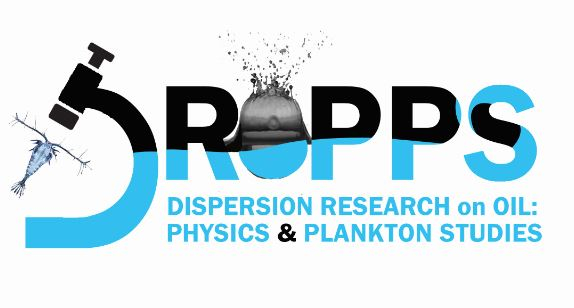Zhao L, Boufadel MC, Adams E, Socolofsky S, King T, Lee K, Nedwed T.
Simulation of scenarios of oil droplet formation from the Deepwater Horizon blowout. Marine Pollution Bulletin [Internet]. 101 (1) :304-319.
Publisher's VersionAbstractKnowledge of the droplet size distribution (DSD) from the Deepwater Horizon (DWH) blowout is an important step in predicting the fate and transport of the released oil. Due to the absence of measurements of the DSD from the DWH incident, we considered herein hypothetical scenarios of releases that explore the realistic parameter space using a thoroughly calibrated DSD model, VDROP-J, and we attempted to provide bounds on the range of droplet sizes from the DWH blowout within 200 m of the wellhead. The scenarios include conditions without and with the presence of dispersants, different dispersant treatment efficiencies, live oil and dead oil properties, and varying oil flow rate, gas flow rate, and orifice diameter. The results, especially for dispersant-treated oil, are very different from recent modeling studies in the literature.
Bacosa HP, Liu Z, Erdner DL.
Natural sunlight shapes crude oil-degrading bacterial communities in northern Gulf of Mexico surface waters. Front. Microbiol [Internet]. 6 (1325).
Publisher's VersionAbstractFollowing the Deepwater Horizon (DWH) spill in 2010, an enormous amount of oil was observed in the deep and surface waters of the northern Gulf of Mexico. Surface waters are characterized by intense sunlight and high temperature during summer. While the oil-degrading bacterial communities in the deep-sea plume have been widely investigated, the effect of natural sunlight on those in oil polluted surface waters remains unexplored to date. In this study, we incubated surface water from the DWH site with amendments of crude oil, Corexit dispersant, or both for 36 d under natural sunlight in the northern Gulf of Mexico. The bacterial community was analyzed over time for total abundance, density of alkane and polycyclic aromatic hydrocarbon degraders, and community composition via pyrosequencing. Our results showed that, for treatments with oil and/or Corexit, sunlight significantly reduced bacterial diversity and evenness and was a key driver of shifts in bacterial community structure. In samples containing oil or dispersant, sunlight greatly reduced abundance of the Cyanobacterium Synechococcus but increased the relative abundances of Alteromonas, Marinobacter, Labrenzia, Sandarakinotalea, Bartonella, and Halomonas. Dark samples with oil were represented by members of Thalassobius, Winogradskyella, Alcanivorax, Formosa, Pseudomonas, Eubacterium, Erythrobacter, Natronocella, and Coxiella. Both oil and Corexit inhibited the Candidatus Pelagibacter with or without sunlight exposure. For the first time, we demonstrated the effects of light in structuring microbial communities in water with oil and/or Corexit. Overall, our findings improve understanding of oil pollution in surface water, and provide unequivocal evidence that sunlight is a key factor in determining bacterial community composition and dynamics in oil polluted marine waters.
Hinow P, Nihongi A, Strickler, Rudi J.
Statistical Mechanics of Zooplankton. PloS one [Internet]. 10 (8).
Publisher's VersionAbstractStatistical mechanics provides the link between microscopic properties of many-particle systems and macroscopic properties such as pressure and temperature. Observations of similar "microscopic" quantities exist for the motion of zooplankton, as well as many species of other social animals. Herein, we propose to take average squared velocities as the definition of the "ecological temperature" of a population under different conditions on nutrients, light, oxygen and others. We test the usefulness of this definition on observations of the crustacean zooplankton Daphnia pulicaria. In one set of experiments, D. pulicaria is infested with the pathogen Vibrio cholerae, the causative agent of cholera. We find that infested D. pulicaria under light exposure have a significantly greater ecological temperature, which puts them at a greater risk of detection by visual predators. In a second set of experiments, we observe D. pulicaria in cold and warm water, and in darkness and under light exposure. Overall, our ecological temperature is a good discriminator of the crustacean's swimming behavior.
Murphy DW, Li C, d'Albignac V, Morra D, Katz J.
Splash behavior and oily marine aerosol production by raindrops impacting oil slicks. Journal of Fluid Mechanics [Internet]. 780 :536-577.
Publisher's VersionAbstractThe high speed impact of a droplet on a bulk fluid at high We is not well understood but is relevant to the production of marine aerosol by raindrop impact on the sea surface. These splashes produce a subsurface cavity and a crown which closes into a bubble canopy, but a floating layer of immiscible oil, such as a crude oil slick, alters splash dynamics. The effects of oil layer fluid properties and thickness and droplet size and impact speed are examined by high speed visualization. Oil layer rupture and crown behavior are classified by dimensional scaling. The subsurface cavity volume for impact on thick layers is shown to depend on Re, though canopy formation at high Re introduces a competing We effect since rapid canopy closure is found to retard cavity expansion. Time-resolved kinematic measurements show that thin crude oil slicks similarly alter crown closure and cavity growth. The size and spatial distributions of airborne droplets are examined using high speed holographic microscopy. Droplets have a bimodal distribution with peaks at 50 and 225 μm and are clustered by size at different elevation angles. Small droplets (50 μm) are ejected primarily at shallow angles, indicating production by splashing within the first 100 μs and by breakup of microligaments. Larger droplets (225 μm) are found at steeper elevation angles, indicating later production by capillary instability acting on large ligaments protruding upward from the crown. Intermittent droplet release while the ligaments grow and sweep upward is thought to contribute to the size-dependent spatial ordering. Greater numbers of small droplets are produced at high elevation angles when a crude oil layer is present, indicating satellite droplet formation from ligament breakup. A crude oil layer also increases the target fluid Oh, leading to creation of an intact ejecta sheet, which then ruptures to form aerosolized oil droplets.
Prosperetti A, Tseng Y-H.
Local interfacial stability near a zero vorticity point. Journal of Fluid Mechanics [Internet]. 776 :5-36.
Publisher's VersionAbstractIt is often observed that small drops or bubbles detach from the interface separating two co-flowing immiscible fluids. The size of these drops or bubbles can be orders of magnitude smaller than the length scales of the parent fluid mass. Examples are tip-streaming from drops or coaxial jets in microfluidics, selective withdrawal, ‘skirt’ formation around bubbles or drops, and others. It is argued that these phenomena are all reducible to a common instability that can occur due to a local convergence of streamlines in the neighbourhood of a zero-vorticity point or line on the interface. When surfactants are present, this converging flow tends to concentrate them in these regions weakening the effect of surface tension, which is the only mechanism opposing the instability. Several analytical and numerical calculations are presented to substantiate this interpretation of the phenomenon. In addition to some idealized cases, the results of two-dimensional simulations of co-flowing jets and a rising drop are presented.
Vaccari L, Allan D, Sharifi-Mood N, Singh A, Leheny R, Stebe K.
Films of bacteria at interfaces: three stages of behaviour. Soft Matter [Internet].
Publisher's VersionAbstractBacterial attachment to a fluid interface can lead to the formation of a film with physicochemical properties that evolve with time. We study the time evolution of interface (micro)mechanics for interfaces between oil and bacterial suspensions by following the motion of colloidal probes trapped by capillarity to determine the interface microrheology. Initially, active bacteria at and near the interface drive superdiffusive motion of the colloidal probes. Over timescales of minutes, the bacteria form a viscoelastic film which we discuss as a quasi-two-dimensional, active, glassy system. To study late stage mechanics of the film, we use pendant drop elastometry. The films, grown over tens of hours on oil drops, are expanded and compressed by changing the drop volume. For small strains, by modeling the films as 2D Hookean solids, we estimate the film elastic moduli, finding values similar to those reported in the literature for the bacteria themselves. For large strains, the films are highly hysteretic. Finally, from wrinkles formed on highly compressed drops, we estimate film bending energies. The dramatic restructuring of the interface by such robust films has broad implications, e.g. in the study of active colloids, in understanding the community dynamics of bacteria, and in applied settings including bioremediation.
Bacosa HP, Erdner DL, Liu Z.
Differentiating the roles of photooxidation and biodegradation in the weathering of Light Louisiana Sweet crude oil in surface water from the Deepwater Horizon site. Marine Pollution Bulletin [Internet]. 95 (1 ) :265-272.
Publisher's VersionAbstractWe determined the contributions of photooxidation and biodegradation to the weathering of Light Louisiana Sweet crude oil by incubating surface water from the Deepwater Horizon site under natural sunlight and temperature conditions. N-alkane biodegradation rate constants were ca. ten-fold higher than the photooxidation rate constants. For the 2–3 ring and 4–5 ring polycyclic aromatic hydrocarbons (PAHs), photooxidation rate constants were 0.08–0.98 day−1 and 0.01–0.07 day−1, respectively. The dispersant Corexit enhanced degradation of n-alkanes but not of PAHs. Compared to biodegradation, photooxidation increased transformation of 4–5 ring PAHs by 70% and 3–4 ring alkylated PAHs by 36%. For the first time we observed that sunlight inhibited biodegradation of pristane and phytane, possibly due to inhibition of the bacteria that can degrade branched-alkanes. This study provides quantitative measures of oil degradation under relevant field conditions crucial for understanding and modeling the fate of spilled oil in the northern Gulf of Mexico.


